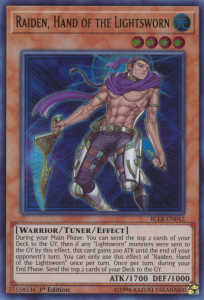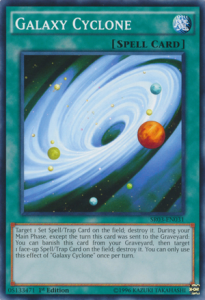It took until July for Nekroz to be taken down from their tier zero throne and allow more breathing room in the meta. Even still, it had to wait until it received both direct and indirect support from Clash of Rebellions and High-Speed Riders.
The person who can be said to have broken down the wall for Infernoids is Erik Christensen. By reader suggestion, we're going to look at the deck with which he made his legendary undefeated run through YCS Dallas 2015. His decklist will be provided below, then we'll talk about what made it so successful.
Swarming from the Void
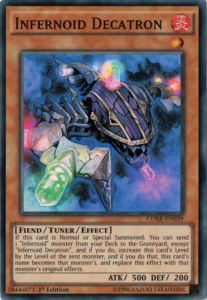 The signature aspect of Infernoids is their ability to banish each other from the hand and graveyard to special summon themselves. Banishing from the hand can help provide early plays, but the best way to get lots of monsters into play is by setting up the graveyard. Of course, there is the restriction of a maximum total level of 8 across all of your monsters on the field. This means that you have to plan ahead and summon smaller monsters first. Reasoning and Monster Gate were your best ways of setting up and beginning to turbo out monsters.
The signature aspect of Infernoids is their ability to banish each other from the hand and graveyard to special summon themselves. Banishing from the hand can help provide early plays, but the best way to get lots of monsters into play is by setting up the graveyard. Of course, there is the restriction of a maximum total level of 8 across all of your monsters on the field. This means that you have to plan ahead and summon smaller monsters first. Reasoning and Monster Gate were your best ways of setting up and beginning to turbo out monsters.Without them, however, it could be difficult to set up for your large monsters like Infernoid Devyaty and Infernoid Onuncu. Both need to banish three Infernoids from the graveyard to summon themselves. That's why Infernoid Decatron was a great addition out of Clash of Rebellions. By summoning it (yes, it's able to be normal summoned too), it could send either Devyaty or Onuncu to the graveyard and copy its effect. This helped provide stronger turns early in the game. Without Devyaty or Onuncu, the only disruption Infernoids have is tributing for a D.D. Crow-esque effect. Decatron could also be summoned off of Reasoning and Monster Gate, which made it a multifaceted threat.
Back when Christensen played the deck, Reasoning was still at three and such an impactful monster to stop on was important. You could still hit a Lightsworn if the opponent called level 1. A reason Infernoid struggled so much up to this point was that someone could've called level 4 every time and prevented Raiden, Hand of the Lightsworn or Lyla, Lightsworn Sorceress from being summoned. Post-Decatron it wasn't so clear-cut.
A Shining Light
Lightsworns were a natural inclusion in the deck. They did everything you wanted them to. Charge of the Light Brigade milled the Infernoids and then searched a monster to use your normal summon on. Those monsters were Raiden and Lyla, who had seen tons of play in Shaddolls over the last year.
On top of being summonable by Reasoning and Monster Gate, they were the magic level 4, milled more cards for your Infernoid engine, and had their own useful applications. Lyla was spell/trap destruction on legs, and Raiden had the coveted "tuner" printed on it. Decatron was a tuner as well, but level 1 could be awkward and there's only three of it in the deck. Raiden gave easier access to level 7 and 8 Synchros such as Clear Wing Synchro Dragon, Black Rose Dragon and PSY-Framelord Omega.
Omega's True Potential
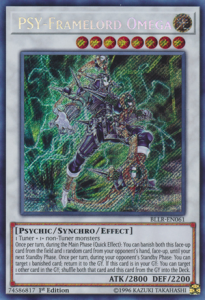 Up until this point, Infernoids were lacking in the go-to card department. Onuncu and Devyaty were great, but they didn't provide that special something. PSY-Framelord Omega filled that gap. A 2800 attack point monster that could temporarily remove itself from the field in trade for a card in the opponent's hand was amazing. Remember, Infernoids have their summoning restricted by the levels currently on the field. Omega essentially clears away levels for the turn while hindering the opponent.
Up until this point, Infernoids were lacking in the go-to card department. Onuncu and Devyaty were great, but they didn't provide that special something. PSY-Framelord Omega filled that gap. A 2800 attack point monster that could temporarily remove itself from the field in trade for a card in the opponent's hand was amazing. Remember, Infernoids have their summoning restricted by the levels currently on the field. Omega essentially clears away levels for the turn while hindering the opponent.That was just the obvious effect though. The community was hyped for a level 8 Synchro that removed a card from the opponent's hand, but the full potential of Omega came in with its returning from banished effect. It returned a banished Infernoid to the graveyard every single turn. This way of maintaining resources was huge for the deck. Christensen said that he made Omega almost every single game and it isn't hard to see why. Between removing itself from the field and recycling Infernoids most important resource, it's practically the perfect card.
Christensen's Tech Choices
What defines the difference between successful and failed deck of the same archetype and variant are tech cards. Christensen included several interesting ones deserving of discussion.
Main Deck
Card Trooper was an odd choice, having not seen much play recently. It mills up to three cards and gains attack for each, then draws a card when it's destroyed. A decent card to normal summon on the first turn in the absence of Reasoning. It's unlikely that the opponent called level 3 on Reasoning, so excavating Card Trooper almost always ends in summoning it. Decatron and Raiden were probably both better cards, but I can see where Card Trooper is a good one-of.
On the other hand, Galaxy Cyclone made perfect sense. If a large chunk of the deck is sent to the graveyard every game, then being able to access spell/trap destruction in the graveyard is very strong. It's a less versatile card in the hand than Mystical Space Typhoon, but both were likely to just end up milled. Better to side Mystical Space Typhoon for matchups that really need it.
Soul Charge was a very popular card in decks with large monsters like this one. Christensen opted for Rekindling instead, which could only summon Decatron from the graveyard. His reasoning being that Rekindling doesn't kill your battle phase and still helps you push for game. Special Summoning multiple Decatrons from the graveyard could be almost if not just as good as anything Soul Charge could do.
Side Deck
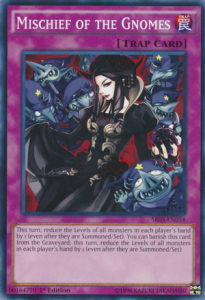
There are a couple cool cards in the side deck too, including Mischief of the Gnomes. Players hyped it as a counter against Burning Abyss and Satellarknights since it alters their levels. It didn't see as much play as expected but it's still a cool card nonetheless.
De-Fusion countered Shaddolls by getting rid of a fusion monster while not allowing them to add Shaddoll Fusion back to their hand. It was pretty useful against Heros too, since Masked Hero Dark Law prevented sending cards to the graveyard.
Breakthrough Skill is notable simply because it has synergy with the Graveyard similar to how Galaxy Cyclone does. Any cards that activate in the graveyard gain considerable playability in this deck.
Conclusion
Erik Christensen realized the untapped potential of Infernoids with their new support and was rewarded with being YCS champion. There may have been other players who also realized it, but he's the one who took the deck all the way to the top. PSY-Framelord Omega, the crown jewel of the deck, remains one of the most prolific extra deck monsters in the modern game.
To make his undefeated run even more incredible, this was the first YCS he had ever attended. It shows that anyone, so long as they're prepared with the right deck, can win. Looking ahead of the curve and identifying the strengths of relatively unsuccessful or unplayed decks could be what it takes for you to take your first place finish.

